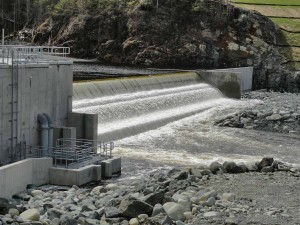
Award of Excellence: Kokish River Hydroelectric Project
October 24, 2015
By Knight Piésold
“This 45 MW run-of-river project in Port McNeill, B.C. has innovative features to provide safe passage for both adult and juvenile steelhead trout and salmon. We also liked the fact that the local First Nation was part of the development team and were able to contribute their in-depth traditional knowledge of the site.” – Jury
From the October-November print edition, p. 63

The Kokish River Hydroelectric Project is a 45 MW run-of-river facility 15 km east of Port McNeill, on the north of Vancouver Island, B.C.
Every step during the development process took into consideration the diversity of fish habitats in Kokish River. The project has unique and innovative details throughout the diversion reach designed to cater to this sensitive environment, and in particular the presence of steelhead trout and salmon.It has one of the largest capacity Coanda screen intakes in the world, together with one of the smallest Obermeyer crest gates in the world, a wrap-around vertical slot fish ladder, and a tailrace fish screen.
As the lead design engineer, Knight Piésold worked closely with the owner, Kwagis Power Limited Partnership, and the EPC Contractor, Peter Kiewit Infrastructure, to develop innovative and cost-effective solutions that more than met the stringent fisheries permitting requirements. The Knight Piésold team was involved throughout the project’s development.
“Fish first” design
The intake and diversion weir were designed to:
— Divert a portion of the natural stream flow to the water conveyance system, while excluding large sediment and debris to limit damage to the pipe and turbine generating equipment.
— Provide safe passage — for both adult and juvenile salmon and steelhead trout — past the intake and diversion weir, for upstream and downstream migration.
— Allow for precise control and real-time flow monitoring of the in-stream flow release downstream of the intake to maintain the natural aquatic ecology. The required in-stream flow releases varied by season and month from 3.4 m3/s to 12 m3/s.
— Allow passage of flood flows without damage to the structure.
The 9.3 km-long water conveyance system is unusually long for a high-head, run-of-river project in B.C. Its design had to be cost-effective, yet robust, because the penstock is exposed to hydraulic transient pressures internally, and logging road traffic and natural forces externally. Over its entire length, its thin-walled pipe sections were designed to be buried in the natural ground. Engineered fills were used to restrain pipe movement, eliminating the need for concrete anchor blocks.
A unique feature of the powerhouse — a fish fence across the tailrace outlet — prevents the adult fish from entering the tailrace, and generates flow patterns that would encourage the fish to continue on their upstream migration.
Diversion weir and intake Coanda screen
The diversion weir and intake structures are designed to ensure that during operations the natural rates of sediment movement are maintained over the life of the project.
A purpose-built 1:12 scale hydraulic model of the intake and diversion weir was tested in Northwest Hydraulic Consultants’ laboratory to verify various aspects of the design..
The diversion weir incorporates Coanda shear effect screens that prevent debris, coarse sediment, and fish from entering the penstock. Knight Piésold conducted extensive research and model testing to optimize the Coanda screen configuration, resulting in a spillway screen through-put capacity that is one of the highest in the world for a hydropower project.
Possibly the world’s smallest multi-segmented Obermeyer crest gate was added immediately upstream of the Coanda screen to allow the concentration of low flows over the weir and prevent fish from being stranded on a seasonally dry screen surface.
Local contributions and benefits
The 28-month project brought direct and indirect socio-economic benefits to the north Vancouver island area, creating work and nearly $30 million in goods and services. Designed and constructed on time and on budget, the run-of-river facility will generate clean renewable energy to power 13,000 homes annually.
The ‘Namgis First Nation was part of the owner’s development team, and provided significant benefits by sharing their in-depth knowledge of the site, the surrounding environment, and traditional use of the area.
Project name: Kokish River Hydroelectric Project, Vancouver Island, B.C.
Award-winning firm (prime consultant/lead design engineer):
Knight Piésold, Vancouver (Sam Mottram, P.Eng., Egbert Scherman, P.Eng., Travis Brown, P.Eng., Katrina Wechselberger, P.Eng.,
Benoit Otis, P.Eng., David Levi, P.Eng., Rob Adams, P.Eng.,
Jamie Cathcart, P.Eng., Daniel Friedman, P.Eng., Oscar Gustafson)
Owner: Kwagis Power Limited Partnership (Brookfield Renewable Energy Group and ‘Namgis First Nation)
Client: Peter Kiewit Infrastructure
Other key players: Peter Kiewit Infrastructure (engineering-procurement-construction contractor), Northwest Hydraulic Consultants (intake scale model testing), Rockwell Automation (design of electrical components and control system)